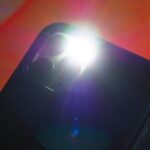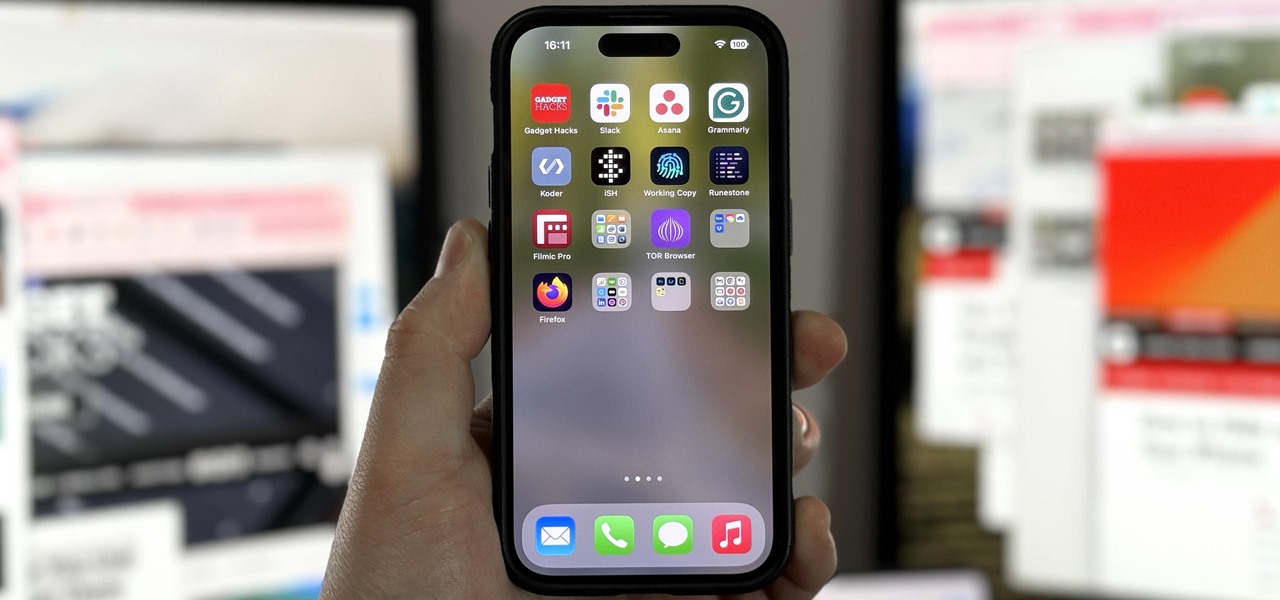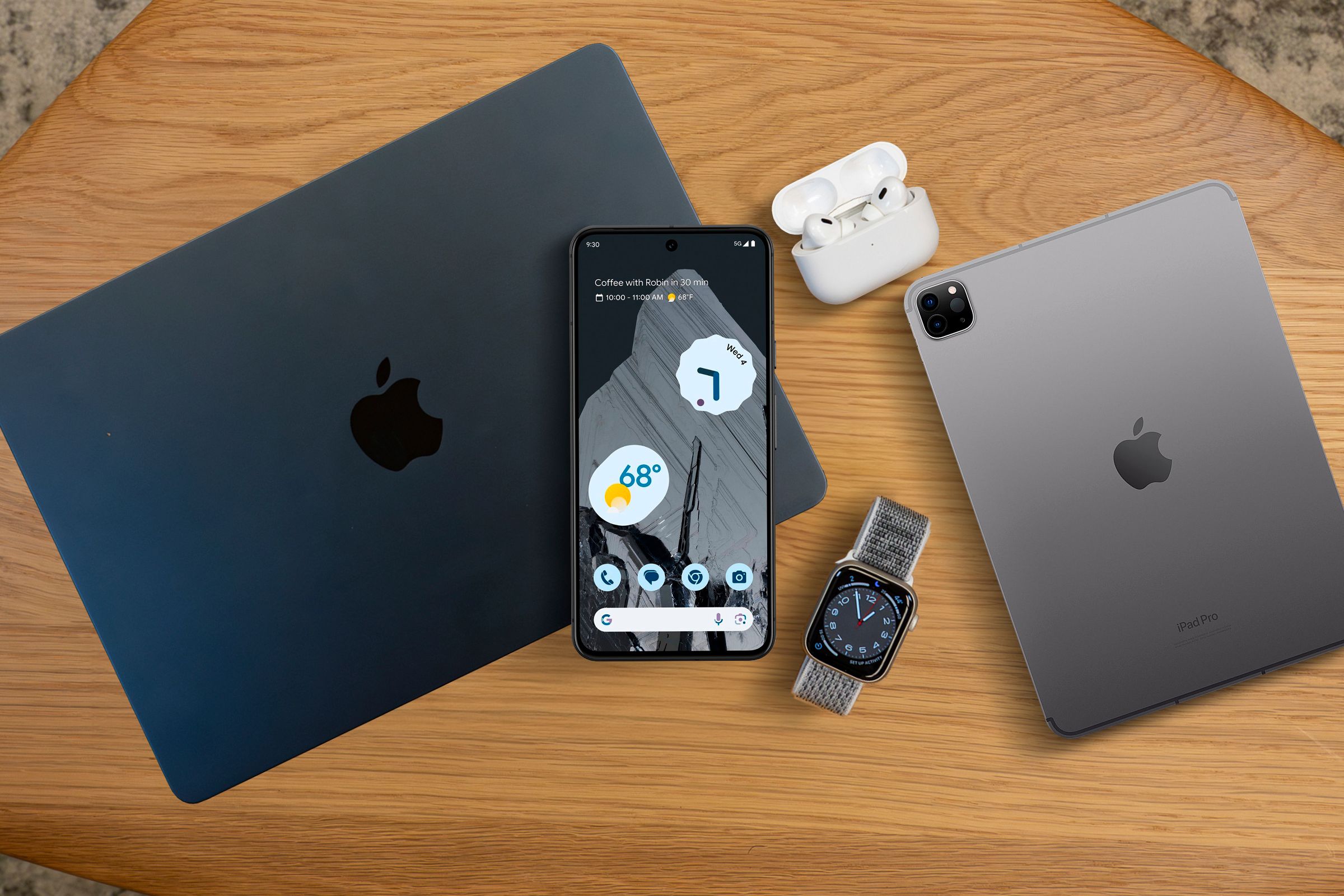Apple has four iPhone models for the remaining months of 2020, but the most impressive ones are the iPhone 12 Pro and iPhone 12 Pro Max. While the iPhone 12 and iPhone 12 mini are great smartphones, the “Pro” models offer more advanced features, especially for photographers and augmented reality enthusiasts.
But if you’re expecting the iPhone 12 and 12 Pro Max to be body clones of the iPhone 11 Pro and 11 Pro Max, you’re sadly mistaken. Apple has mixed things up a bit this year, so the display sizes are different, and there are more new features than one would expect Apple to implement.
- Don’t Miss: What You Need to Know About the iPhone 12 & 12 Mini
Jump to a section: Dates | Storage | Prices | Body | Basics | Display | Performance | Battery | MagSafe | Rear Camera | Front Camera | Audio | Sensors | Connectivity | Security | Software | Media Formats | In the Box
Important Dates
On Oct. 13, 2020, Apple officially announced the iPhone 12 Pro and 12 Pro Max alongside their slimmed-down cousins, the iPhone 12 and 12 mini. They were announced in an online-only event due to coronavirus health hazards, directly from Apple Park. At that event, Apple gave away the preorder and release dates for the iPhone 12 Pro and 12 Pro Max.
The iPhone 12 Pro (along with the iPhone 12) can be preordered starting at 5 a.m. PDT on Friday, Oct. 16, 2020, and it will be released on Oct. 23. The iPhone 12 Pro Max (along with the iPhone 12 mini) can be preordered starting at 5 a.m. PST on Friday, Nov. 6, 2020, and it will be released on Nov. 13.
- Announcement date: Oct. 13, 2020
- iPhone 12 Pro preorder date: Oct. 16, 2020
- iPhone 12 Pro Max preorder date: Nov. 6, 2020
- iPhone 12 Pro release date: Oct. 23, 2020
- iPhone 12 Pro Max release date: Nov. 13, 2020
Storage
While its little siblings start with 64 GB of storage space, the iPhone 12 Pro and 12 Pro Max go one step further. The newest Pro models start at 128 GB, just like the iPhone 11 Pro models do, and they still have 256 GB and 512 GB as the medium and large base storage options.
No expandable options are available, but you can connect external drives via the Lightning port to access files and media. That includes APFS encrypted drives that can be accessed using the Files app.
- Storage available: 128 GB, 256 GB, 512 GB
- Expandable storage: no, but external drives are supported
Prices
Like the 11 Pro and 11 Pro Max models, the 12 Pro and 12 Pro Max are more expensive than the regular iPhone 12 and 12 mini. And while the base storage models cost the same as the 11 Pro and 11 Pro Max, at $999 and $1,099, respectively, the 256 GB and 512 GB iPhone 12 Pro and 12 Pro Max are actually cheaper than last year’s.
As with previous iPhones, you get a one-year limited warranty and up to 90 days of complimentary tech support. With AppleCare+ and AppleCare+ with Theft and Loss, the warranty expands to two years, and you get additional features such as accidental damage protection (up to two incidents) and 24/7 tech support. Base-tier AppleCare+ is $199, but for $299, you’ll also get theft and loss protection.
If you use the iPhone Upgrade Program, one of these protection plans is automatically included in the pricing. And if you use an Apple Card to make monthly payments, the monthly cost is cheaper ($8.29 and $11.20) than if you were to pay for it monthly outside of the iPhone Upgrade Program ($9.99 and $13.49).
- iPhone 12 Pro price: $999 (128 GB); $1,099 (256 GB); $1,299 (512 GB)
- iPhone 12 Pro Max price: $1,099 (128 GB); $1,199 (256 GB); $1,399 (512 GB)
- AppleCare+: $9.99/mo or $199/yr ($8.29/mo with Apple Card installments)
- AppleCare+ with Theft and Loss: $13.49/mo or $269/yr ($11.20/mo with Apple Card installments)
- iPhone 12 Pro, 128 GB, Gold
- iPhone 12 Pro, 128 GB, Graphite
- iPhone 12 Pro, 128 GB, Pacific Blue
- iPhone 12 Pro, 128 GB, Silver
- iPhone 12 Pro Max, 128 GB, Gold
- iPhone 12 Pro Max, 128 GB, Graphite
- iPhone 12 Pro Max, 128 GB, Pacific Blue
- iPhone 12 Pro Max, 128 GB, Silver
Body
For the body, Apple has taken inspiration from past devices, specifically the box design of the iPhone 4, 4S, 5, 5C, 5S, and SE (1st generation), which was first reinvigorated on Apple’s newer iPad models. Instead of the rounded edges that the 2019 iPhone models had, there are smooth, flag edges with a surgical-grade stainless steel band.
From the looks of it, the visible antenna bands are in the same placement as the 2019 models. That means one band on top by the rear camera housing, one above the Side button, one on the opposite end of that side, one above the Ring/Silent switch, one on the opposite end of that side, and one on the bottom to the left.
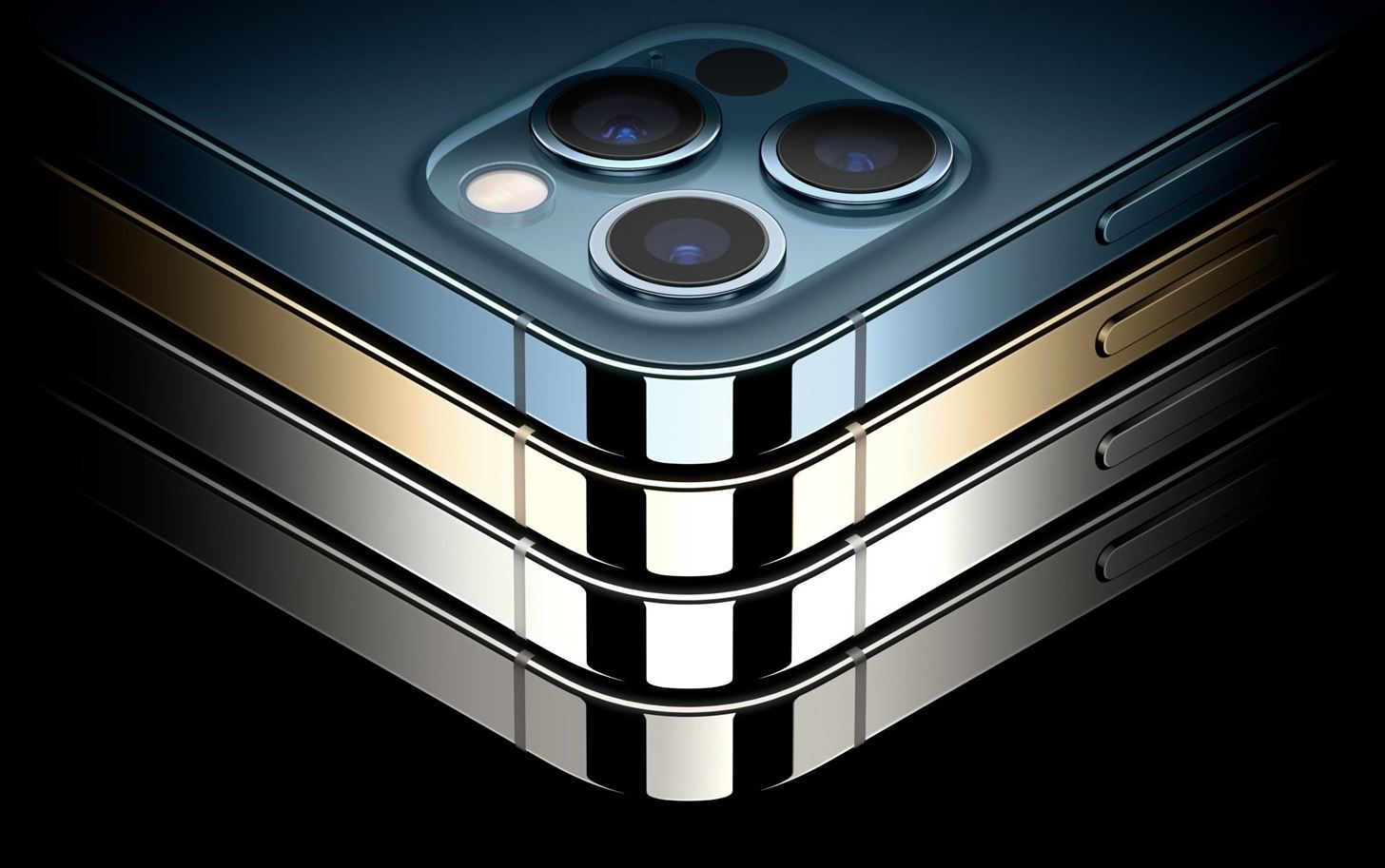
The bezels on the front of the iPhone 12 Pro and 12 Pro Max are smaller thanks to the new stainless steel bands, but it’s hardly noticeable even though Apple advertises “less bezel, more screen.”
As for the finishes, there are four available colors to choose from: silver, graphite, gold, and pacific blue. The rear is textured precision-milled matte glass. And the front has a durable Corning-made Ceramic Shield, which Apple says is stronger than any smartphone glass available; it’s glass infused with nano-ceramic crystals, which improves toughness and increases its drop performance by four times compared to the iPhone 11 Pro and 11 Pro Max’s glass. The front glass also has a fingerprint-resistant oleophobic coating.
- Frame: stainless steel
- Back: matte glass
- Front: Corning Ceramic Shield glass
- Front coating: fingerprint-resistant oleophobic coat
- Finish: silver, graphite, gold, pacific blue
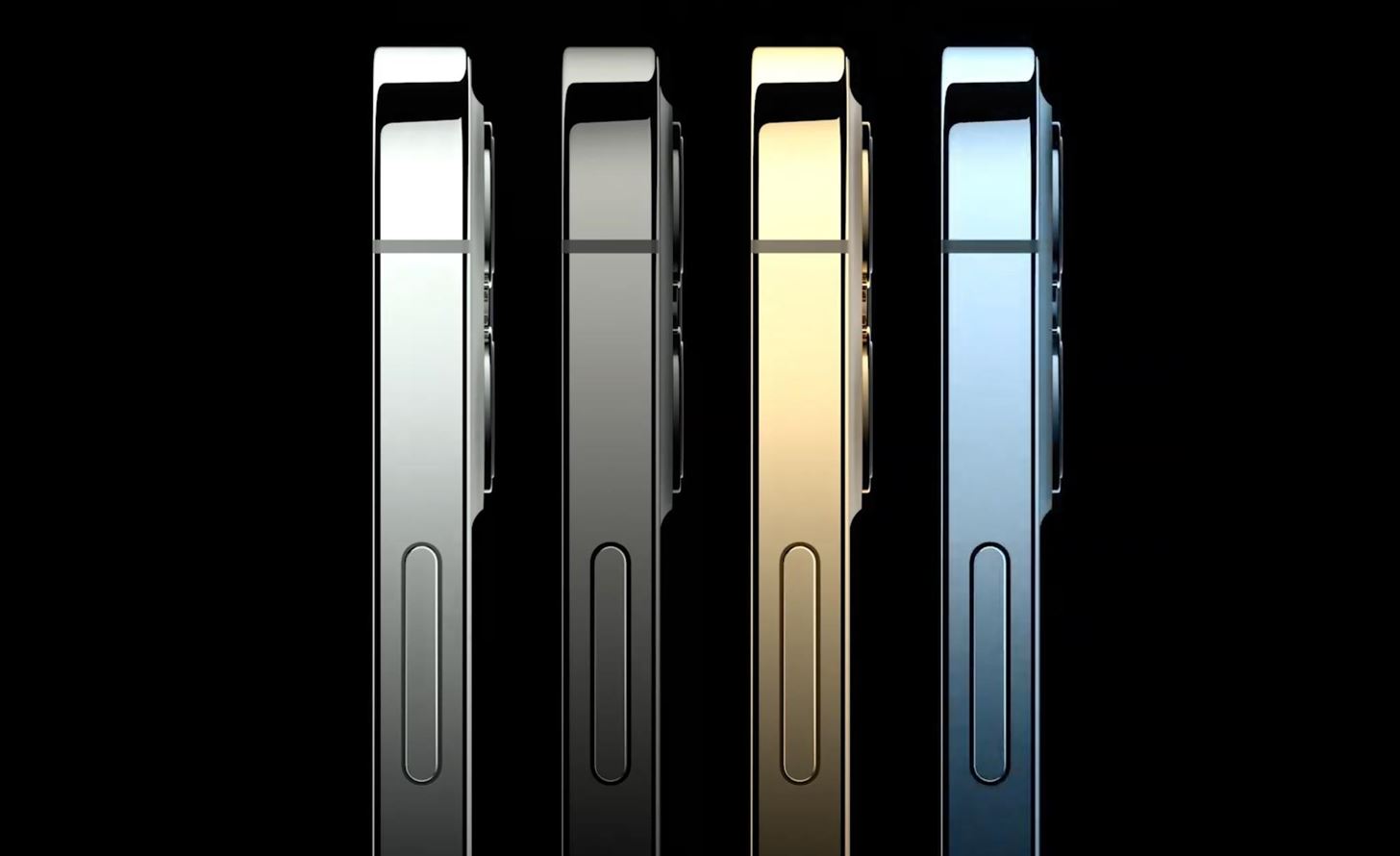
Basics
The iPhone 12 Pro and 12 Pro Max both have larger displays than their predecessors, but more so on the height, where there’s a 0.11-inch increase. There’s only a 0.01-inch increase for the width, and the depth of each is actually 0.03 inches thinner than the iPhone 11 Pro and 11 Pro Max. As for weight, the newer devices are barely any heavier that you wouldn’t notice a difference.
While Apple has gotten an IP68 rating under IEC standard 60529, just like the older models, the iPhone 12 Pro and 12 Pro Max can actually go deeper submerged in water at up to six meters compared to the 2019 models’ four meters. So if you like underwater photography, that should be good news to your ears.
- Height: 5.78 in. (146.7 mm) / 6.33 in. (160.8 mm)
- Width: 2.82 in. (71.5 mm) / 3.07 in. (78.1 mm)
- Depth: 0.29 in. (7.4 mm)
- Weight: 6.66 oz. (189 g) / 8.03 oz. (228 g)
- Dust/water resistance: IP68 (max depth of 6 meters for up to 30 minutes) under IEC standard 60529
- Mobile network operators: AT&T, T-Mobile, Verizon Wireless
For the environmental operating requirements, they’ve been the same since the iPhone 7:
- Operating temp: 32° to 95° F (0° to 35° C)
- Nonoperating temp: -4° to 113° F (-20° to 45° C)
- Relative humidity: 5% to 95% noncondensing
- Operating altitude: tested up to 10,000 feet (3,000 m)
Display
The displays on both new Pro models are larger than the 2019 versions; 6.1 inches and 6.7 inches for the iPhone 12 Pro and Pro Max, respectively, compared to 5.8 inches and 6.5 inches on the iPhone 11 Pro and 11 Pro Max. However, all of these models have the Super Retina XDR display, an all-screen OLED display, housed under the Ceramic Shield glass.
The notches are similar, if not identical, to last year’s models, and there’s still only a 60 Hz refresh rate, which is disappointing, especially for gamers. Many of the same features come back in the newer models, such as HDR support, True Tone ambiance, a 60 Hz refresh rate, a P3 color space, 1,200 nits max brightness, and no 3D Touch.
- Screen size: 6.1 inches (12 Pro) / 6.7 inches (12 Pro Max)
- Screen resolution: 2532 by 1170 px (12 Pro) / 2778 by 1284 px (12 Pro Max)
- Pixel density: 460 ppi (12 Pro) / 458 ppi (12 Pro Max)
- Screen type: OLED, Super Retina XDR
- HDR: Dolby Vision and HDR10
- Notch: yes
- Screen-to-body ratio: currently unknown
- Aspect ratio: 19.5:9
- Minimum brightness: unknown
- Maximum brightness: 800 nits (typical) and 1,200 nits (HDR)
- Ambiance: True Tone
- Refresh rate: 60 Hz
- Color temperature: unknown
- Color space: wide color (P3)
- 3D Touch: no
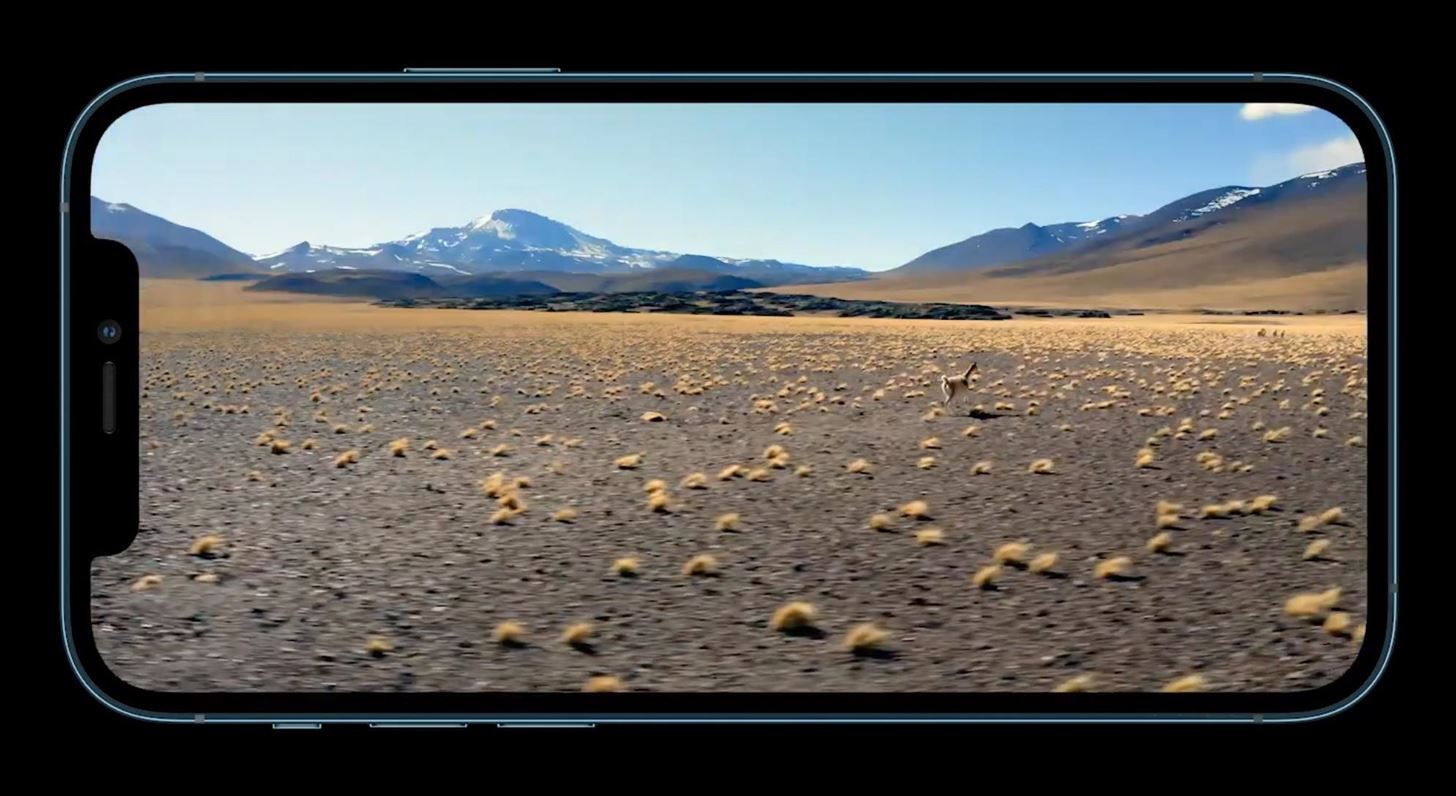
Performance
As suspected, the iPhone 12 Pro and 12 Pro Max are built off the A14 Bionic chip, Apple’s latest architecture, which first appeared in the iPad Air (4th generation). It’s the first smartphone chip that uses a five-nanometer process technology, so it’s tiny but powerful.
The neural processing unit in the chip, Apple’s Neural Engine, has been upgraded from 8 cores to 16 cores, meaning it can now perform 11 trillion operations per second. And the GPU has been upgraded to be 50% faster for graphics so that you can play “console-quality” games, one of which is the new “League of Legends: Wild Rift” by Riot Games.
The amount of memory on board hasn’t been announced by Apple, but it’s suspected to be 6 GB RAM, 2 GB more than the 2019 models.
- Memory: 6 GB RAM
- Processor: Apple A14 Bionic
- Chip size: 5 nm
- Coprocessor: unknown
- CPU frequency: unknown
- CPU cores: 6 cores, 64 bits, ARMv8 ISA (2 Firestorm cores are high-performance; 4 Icestorm cores are energy-efficient)
- Neural processing unit: 16-core Neural Engine
- GPU: Apple-designed (unknown model)
- GPU cores: 4 cores
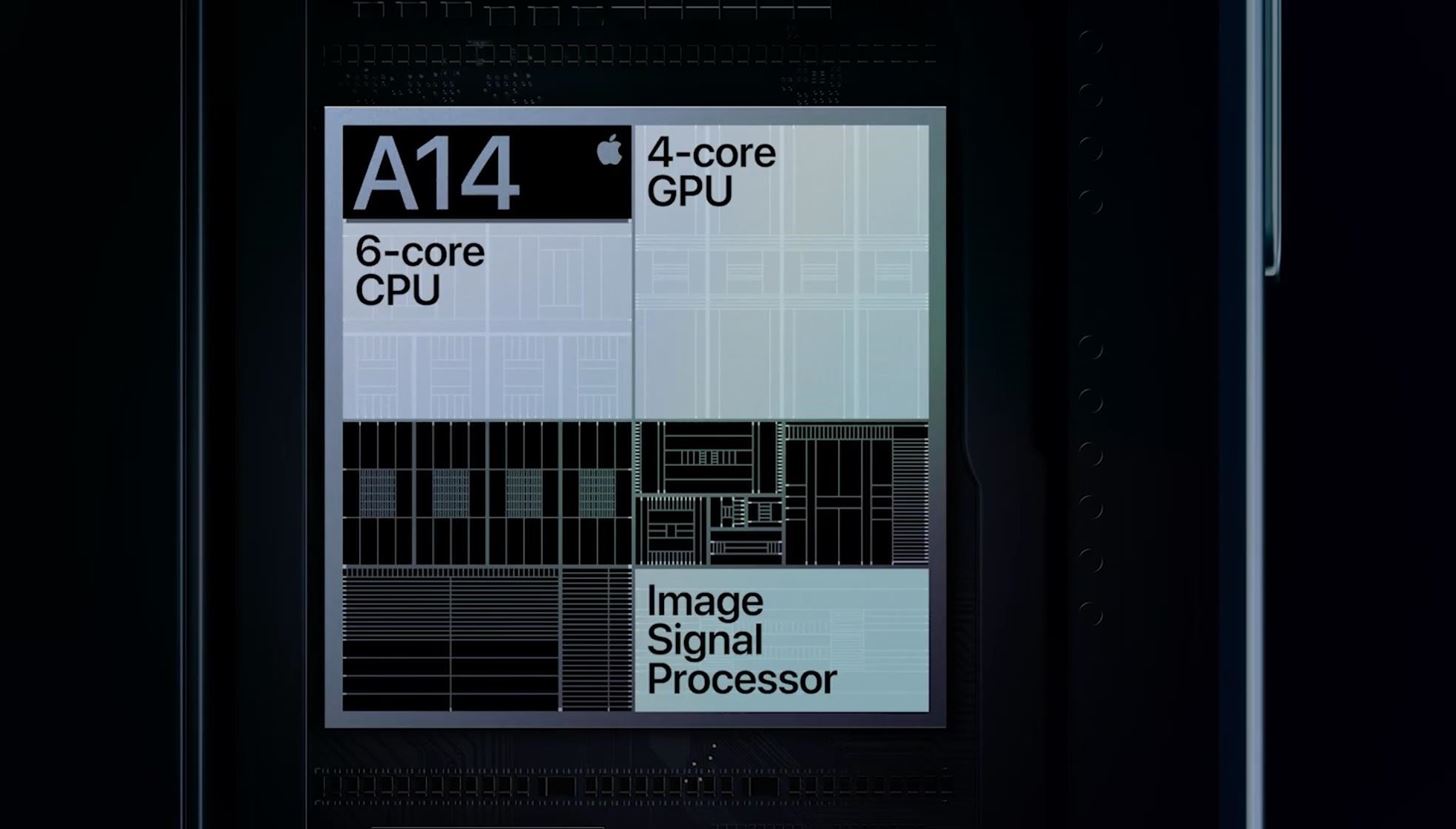
Battery
Apple doesn’t release battery size information about its phones, so we’ll have to wait until some teardowns show us the battery capacity for each device. Until then, know that the iPhone 12 Pro can play video for up to 17 hours, stream video for up to 11 hours, and play audio for up to 65 hours on one charge. The iPhone 12 Pro Max can play video for up to 20 hours, stream video for up to 12 hours, and play audio for up to 80 hours on one charge.
The biggest change you’ll notice after opening up a newer iPhone model’s packaging is that there is no power adapter included. Apple is no longer included a power brick to cut down on costs and improve its carbon footprint since many people already have power adapters, wireless charging pads, computers, and other devices to connect to.
It’s good the typical 7.5 watts for wireless charging, 18 watts for USB Power Delivery, and you can fast-charge with a 20-watt or higher USB-Type C power adapter. A fast charge gives you up to a 50% charge in around 30 minutes. Apple used the Apple USB-C Power Adapter (20W Model A2305) to get those numbers, which isn’t even out yet but likely will be soon.
The best new battery-related feature is the MagSafe wireless charging. With it, your iPhone will never fall off of a charging pad again, as long as you have one that supports the feature. Even better: you get up to 15 watts charging speeds wireless using a MagSafe charger, which is twice as fast as your Qi pad.
- Battery: rechargeable lithium-ion
- Capacity: unknown
- Wireless charging: yes, Qi standard (7.5 W)
- MagSafe wireless charging: yes, up to 15 W
- Charging port: Lightning
- Wired charging: yes, USB PD (18 W)
- Fast charging: yes, with 20 W adapter or higher

MagSafe
Speaking of MagSafe, Apple has brought back the name from its heyday on the MacBook to describe the magnetic ring attached to the inside of the iPhone 12 Pro and 12 Pro Max’s back cover, right around the wireless charging coil.
The magnetic array creates a more efficient wireless charging system at greater speeds while still supporting your typical Qi-based charging pad. Apple’s MagSafe charging products include the MagSafe Charger and MagSafe Duo Charger, the latter of which can also charge your Apple Watch.
More importantly, it opens up the iPhone to new easy-attach accessories. Apple has its own silicon, leather, and clear cases that easily snap onto the back of the iPhone. It’s not that its cases fell off before or anything, but it offers another degree of security; for example, if you were to get Apple’s new leather wallet case, so it’s always securely fastened. Third-party accessory makers will surely come out with more innovative gear.
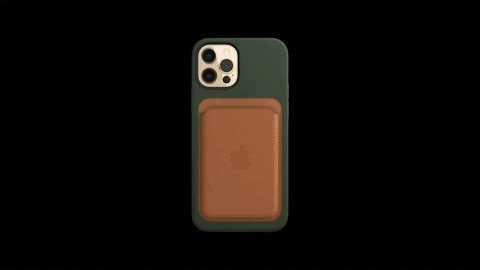
Rear Camera
The rear pro camera system is actually worth the upgrade alone. While it still has three lenses — the ultra-wide, wide, and telephoto — there’s also a new lidar sensor, which will go into more detail very soon.
First, let’s talk about the wide lens; it’s now at ƒ/1.6 versus ƒ/1.8 like it was before, which is the fastest ever on an iPhone. The wide lens is also a seven-element lens; that means 27% improved low-light performance for photos and videos. Its sensor is also 47% larger with 1.7µm pixels, and that also improves low-light shots by 87%.
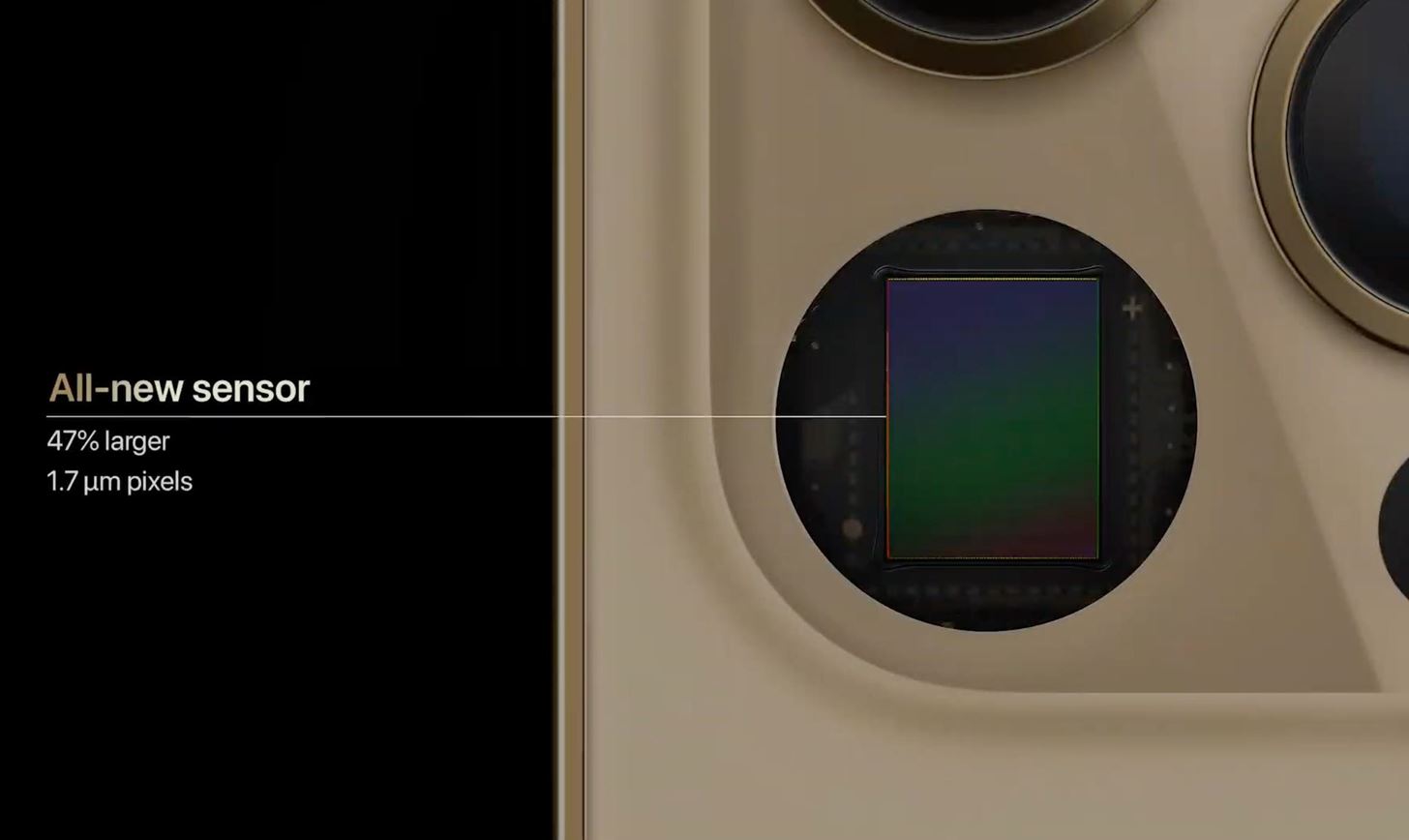
An even more impressive feature that the wide lens incorporates is sensor-shift optical image stabilization, but only on the iPhone 12 Pro Max. The sensor is stabilized instead of the lens itself, which is actually a nice cost-cutting move on Apple’s part since lenses are more expensive with OIS built-in.
On DSLR cameras, sensor-shift OIS is preferred by many because it allows you to replace the camera, which is usually cheaper than individual high-grade lenses. That doesn’t matter on the iPhone, but it does help control motion better while maintaining sharpness since a sensor is not as heavy as a lens. It aids in canceling low- and high-frequency disturbances, such as hand movements and car vibrations.
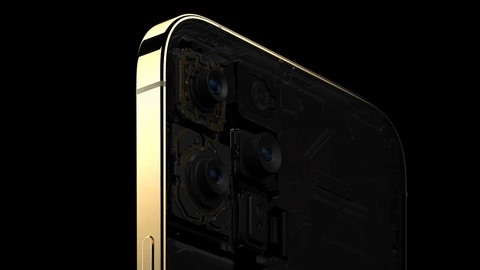
As for the ultra-wide five-element lens on the iPhone 12 Pro and 12 Pro Max, it’s the same as before with a ƒ/2.4 aperture and 120° field of view, so it’s good for capturing more in tight spots, as well as epic landscapes.
When it comes to the telephoto six-element lens, the iPhone 12 Pro and 12 Pro Max differ significantly. The iPhone 12 Pro has the same ƒ/2.0 aperture as before, as well as the same 52 mm focal length that makes portraits easy. So it’s 2.0 times zoom in, and 2.0 times zoom out, for a combined 4.0 times zoom range for photos and video recording. Just like before. And the digital zoom is 10.0 times for photos.
However, the iPhone 12 Pro Max’s is now ƒ/2.2, and its focal length has been increased to 65 mm. That means you get 2.5 times zoom in, and 2.0 zoom out, for a combined 5.0 times zoom range for photos and videos. So you can get closer shots and tighter crops in photos with the biggest 2020 iPhone model. And the digital zoom is 12.0 times for photos.
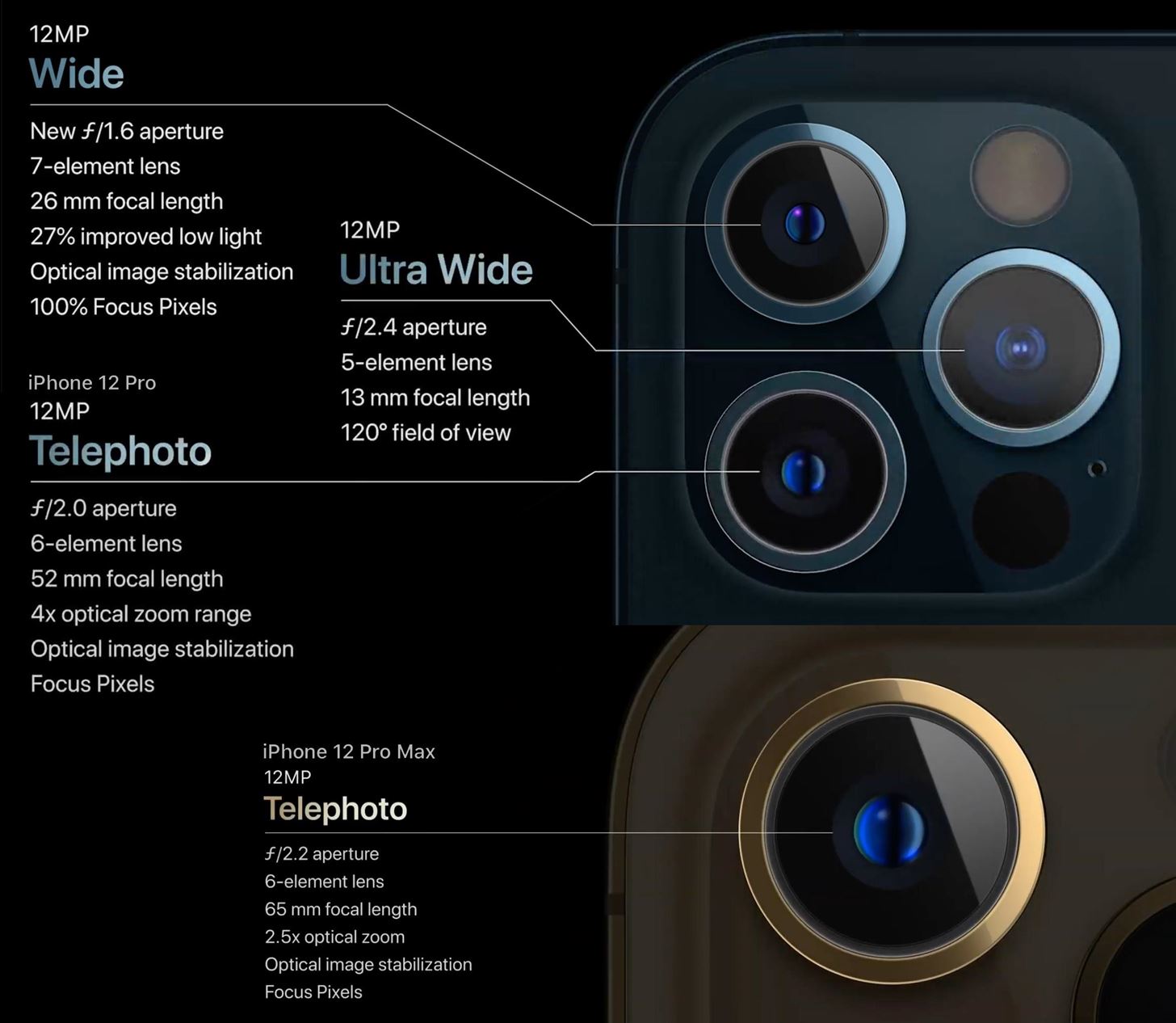
Both models have an improved image signal processor on the A14 Bionic chip, which “increase[s] image quality and enables powerful computational photography capabilities not possible with traditional cameras.”
And both come with a state-of-the-art LiDAR Scanner for immersive augmented reality experiences. The lidar sensor also provides you with faster autofocusing (six times faster) in low-light conditions since it can measure light distance and use pixel depth information for any given scene. That, in turn, provides more accuracy and speedier capture time. It also paves the way for Night mode portrait photography, for even better bokeh effects.
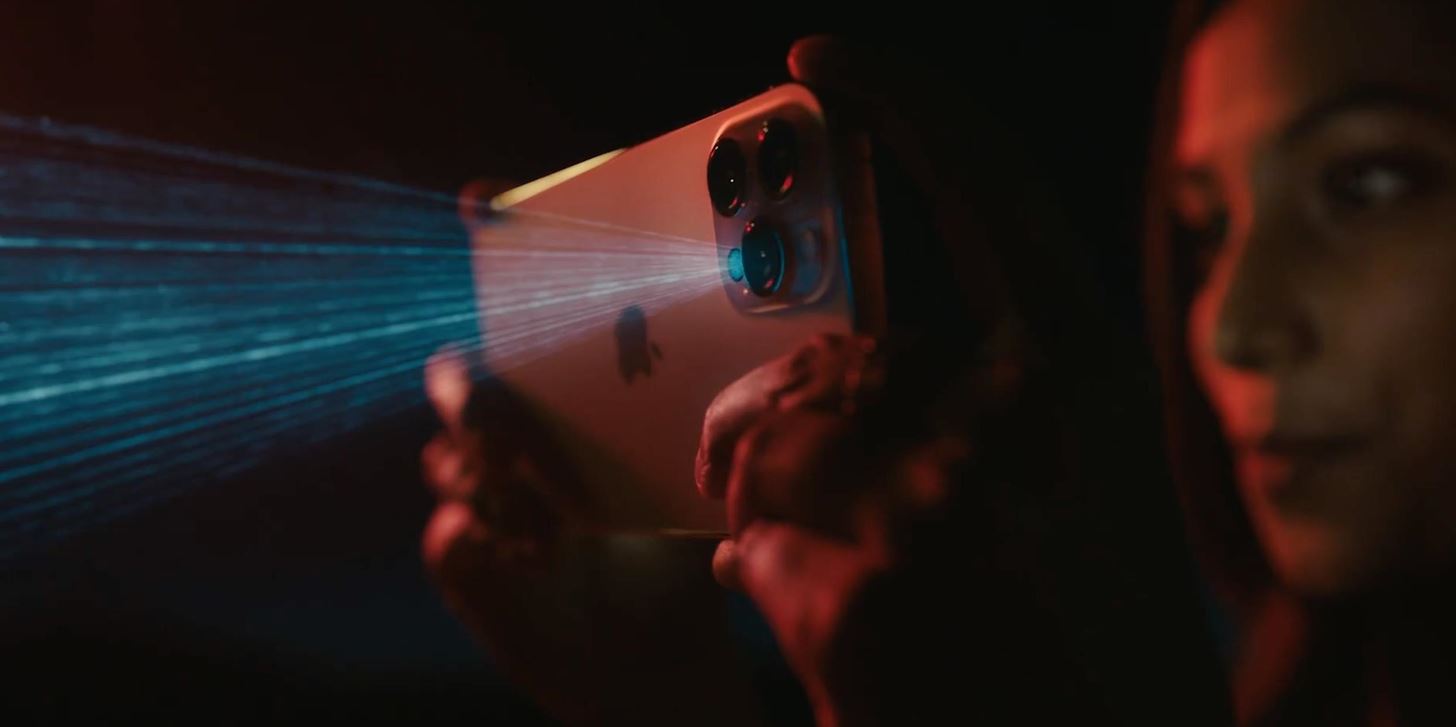
Speaking of Night mode, it’s not just for the wide lens anymore since the ultra-wide lens can use it too. That means even brighter pictures in more scenarios. And Deep Fusion is better and faster than ever before and works on all three rear lenses now, not just the wide or telephoto. The new Smart HDR 3 also improves photos with more true-to-life images, even in complex scenes, since it can detect different environments.
Last but not least, there’s a new Apple ProRAW format that’s coming in a future iOS 14 update. RAW has given you more editing power over photos, but Apple ProRAW is the next step forward for a smartphone camera. It “combines Apple’s multiframe image processing and computational photography with the versatility of a RAW format. Users can experience full creative control over color, detail, and dynamic range natively on iPhone or with other professional photo editing apps.”
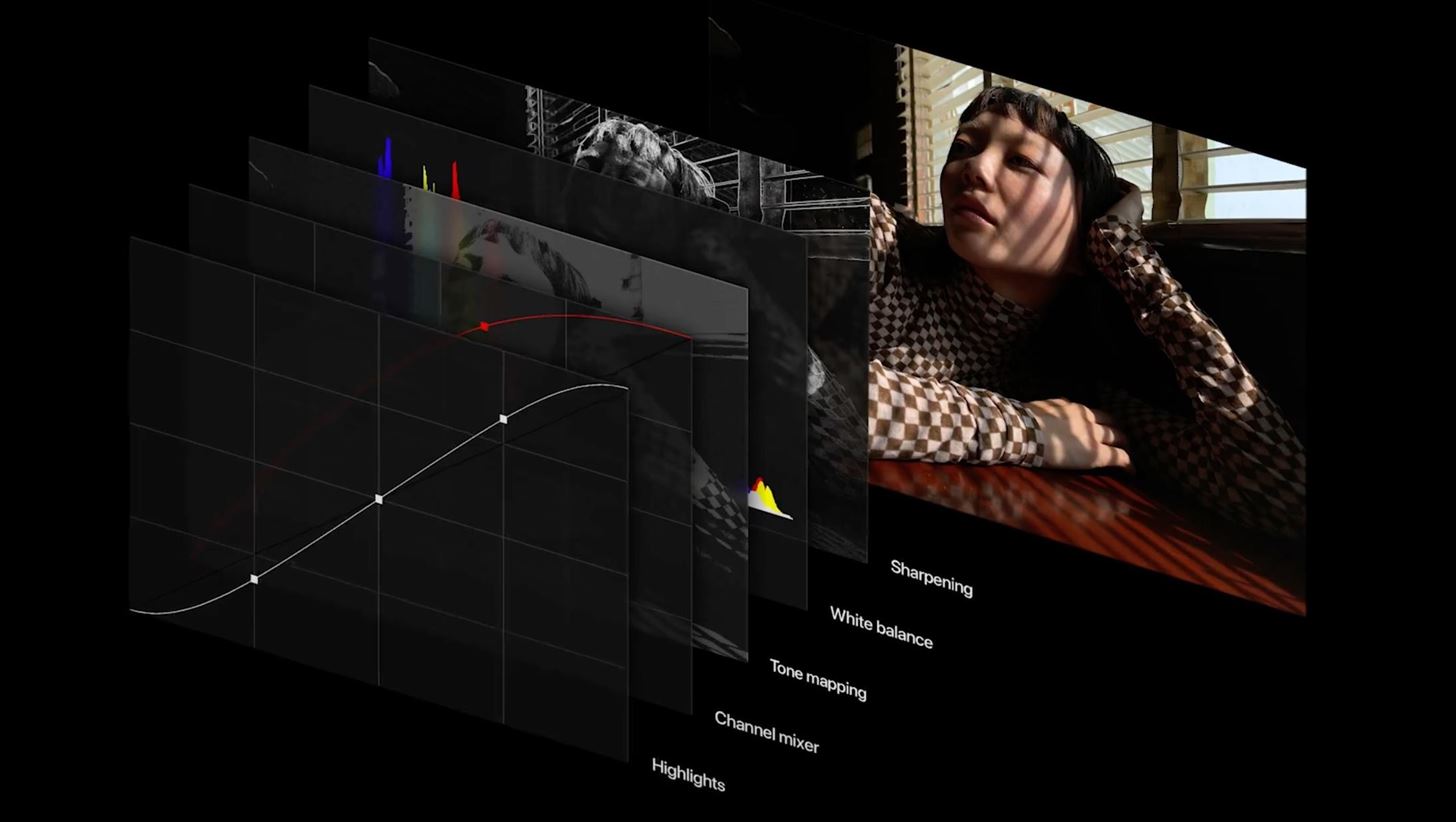
Apple’s new pipeline for Apple ProRAW takes components of the processing performed by the CPU, GPU, image signal processor (ISP), and Neural Engine, then combines them into a deep image file. This all happens at the time of capture, using any of the cameras, so there is no shutter delay. Instead of being baked into the photo, the different layers of sharpening, white balance, tone mapping, channel mixing, and highlights all act independently so you can pro-level edits to your photos.
Editing can be performed right in the Photos app, as well as in third-party photo-editing apps. And Apple even has an API for shooting in Apple ProRAW that other developers can use in their apps.

- Resolution: 12 MP for all three lenses
- Aperture: ƒ/1.6 wide, ƒ/2.4 ultrawide, ƒ/2.0 telephoto (12 Pro) / ƒ/2.2 telephoto (12 Pro Max)
- Optical zoom: 4x optical (12 Pro) / 5x optical (12 Pro Max)
- Digital zoom: 10x (12 Pro) / 12x (12 Pro Max)
- Flash: Quad-LED True Tone flash with Slow Sync
- Image stabilization: auto optical image stabilization on wide and telephoto; and sensor-shift optical image stabilization on the 12 Pro Max’s wide lens
- Time of Flight lens: no
- RAW support: yes, RAW and Apple ProRAW
- Lens cover: sapphire crystal
- Object detection: bodies, faces
- Formats: HEIF, JPEG, RAW, Apple ProRAW
- HDR: Smart HDR 3
- Portrait lighting: yes, six effects
- Night mode: yes, for ultra-wide, wide, and portraits
- Panorama: yes, up to 63 MP
- Other: Burst mode, geotagging, red-eye correction, lens correction (ultra-wide), wide color capture for photos and Live Photos, Deep Fusion, 100% focus pixels (wide)
When it comes to videos, the iPhone 12 Pro and 12 Pro Max are even more impressive. Just like with photos, there’s improved low-light performance and the same optical zoom features. For digital zoom, the iPhone 12 Pro gets 6.0 times while the 12 Pro Max gets 7.0 times. And overall, video stabilization has improved.
With the lidar sensor, you also get faster autofocusing, as well as Night mode Time-Lapse videos. The latter helps give you longer exposure times, sharper videos, better light trails, and smoother exposures in dark conditions with a tripod.
The iPhone 12 Pro and 12 Pro Max also introduce HDR video with Dolby Vision. They are the first cameras to provide an end-to-end experience for HDR video with Dolby Vision at up to 60 frames per second. And best of all, according to Apple, “Dolby Vision grading is processed live and sustained during editing, whether in the Photos app or iMovie, and [is] coming to Final Cut Pro X later this year.”
- Resolution: 720p, 1080p, 4K, and HDR with Dolby Vision
- Max frame rate: 30 fps for 720; 60 fps for 1080p, 4K, and HDR with Dolby Vision
- Slow motion: up to 1080p at 240 fps
- Time-lapse: yes, with stabilization and Night mode
- Photos: 8 MP stills while recording 4K
- Optical zoom: 4x optical (12 Pro) / 5x optical (12 Pro Max)
- Digital zoom: 6x (iPhone 12 Pro) / 7x (iPhone 12 Pro Max)
- Flash: Quad-LED True Tone flash
- Image stabilization: Cinematic video stabilization (4K, 1080p, and 720p)
- Lens cover: sapphire crystal
- Object detection: bodies, faces
- Audio: stereo sound with audio zoom
- Formats: H.264, H.65 (HEVC)
- Other: playback zoom, continuous autofocus, extended dynamic range for up to 60 fps, QuickTake video
Front Camera
An interesting new feature for the front TrueDepth camera is that it supports Night mode. It also has HDR video recording with Dolby Vision up to 30 frames per second. Night mode also works on time-lapse videos, and many other features seen above transfer over to the front camera system too. One of the best new features that the rear system got that the TrueDepth camera also has is Apple ProRAW capabilities.
- Resolution (Photos): 12 MP
- Resolution (Videos): 1080p and 4K
- Max frame rate: 60 fps for 1080p and 4K
- Slow motion: yes, 1080p at 120 fps
- HDR with Dolby Vision recording: yes, up to 30 fps
- Aperture: ƒ/2.2
- Zoom: unknown
- Flash: screen-based (Retina Flash)
- Image stabilization: software-based auto stabilization; cinematic video stabilization (4K, 1080p, and 720p)
- RAW support: unknown
- Object detection: bodies, faces, winks, tongues
- Formats: HEIF, JPEG, Apple ProRAW
- Night mode: yes, including time-lapses
- Portrait mode: yes, with advanced bokeh and Depth Control
- Portrait Lighting: yes, with six effects
- Time-lapse: yes, with stabilization and Night mode support
- Other: Animoji and Memoji, Burst mode, Deep Fusion, Smart HDR 3 with Scene Detection, QuickTake video, lens correction, wide color capture for photos and Live Photos, extended dynamic range for video up to 30 fps
Audio
Apple didn’t announce any real improvements to the audio capabilities this time around, so it’s the same as last year, and the headphone jack isn’t coming back (neither is the adapter). For audio formats, see Media Formats below.
- 3.5 mm headphone jack: likely no
- Stereo speakers: yes
- Mics: three total (on rear, front, and bottom)
- Max speaker volume: unknown
Sensors
The iPhone 12 Pro and 12 Pro Max carry on the sensors of its predecessors.
- Sensors: GPS, barometer, accelerometer, three-axis gyroscope, proximity sensor, barometer, digital compass, Face ID
Connectivity
Apple has finally added 5G support to its lineup of iPhones, and all late-2020 models support it. With 5G connectivity, you get faster speeds and less latency, but only in the U.S.
Since 5G isn’t everywhere yet, the models still support 4G LTE, so you will have no trouble getting a signal. And to save battery, the iPhone 12 Pro and 12 Pro Max use Smart Data Mode, which will only use 5G speeds when necessary. That way, you don’t waste battery power since 5G can drain it much faster than 4G LTE.
The devices are capable of connecting to both sub-6 GHz and mmWave 5G. Sub-6 GHz isn’t quite as fast as mmWave (between 100–150 Mbps for downloads) since the latter can reach speeds of up to 1 Gbps for downloads. While 150 Mbps is speedy in its own right, if you’re looking for the best of the best, you’ll want to look out for an iPhone with mmWave technology for sure.
However, Apple claims that it can support up to 3.5 Gbps download speeds for 5G, and up to 4 Gbps download speeds (and 200 Mbps upload speeds) on Verizon’s 5G Ultrawide Band. So your mileage may vary.
- Wi-Fi: Wi-Fi 6 (802.11ax) with 2×2 MIMO
- Bluetooth: 5.0
- NFC: yes, with reader mode
- SIM card: dual Nano-SIM card tray
- LTE: Gigabit LTE with 4×4 MIMO and LAA4
- 5G: 5G (sub-6 GHz and mmWave)
- Spatial awareness: Ultra Wideband chip
- Port: Lightning
- Other: iBeacon microlocation, AirPlay, AirDrop
- Transit: Express Cards with power reserve
Model A2341
- 5G NR (Bands n1, n2, n3, n5, n7, n8, n12, n20, n25, n28, n38, n40, n41, n66, n71, n77, n78, n79)
- 5G NR mmWave (Bands n260, n261)
- FDD-LTE (Bands 1, 2, 3, 4, 5, 7, 8, 12, 13, 14, 17, 18, 19, 20, 25, 26, 28, 29, 30, 32, 66, 71)
- TD-LTE (Bands 34, 38, 39, 40, 41, 42, 46, 48)
- CDMA EV-DO Rev. A (800, 1900 MHz)
- UMTS/HSPA+/DC-HSDPA (850, 900, 1700/2100, 1900, 2100 MHz)
- GSM/EDGE (850, 900, 1800, 1900 MHz)
Model A2342
- 5G NR (Bands n1, n2, n3, n5, n7, n8, n12, n20, n25, n28, n38, n40, n41, n66, n71, n77, n78, n79)
- 5G NR mmWave (Bands n260, n261)
- FDD-LTE (Bands 1, 2, 3, 4, 5, 7, 8, 12, 13, 14, 17, 18, 19, 20, 25, 26, 28, 29, 30, 32, 66, 71)
- TD-LTE (Bands 34, 38, 39, 40, 41, 42, 46, 48)
- CDMA EV-DO Rev. A (800, 1900 MHz)
- UMTS/HSPA+/DC-HSDPA (850, 900, 1700/2100, 1900, 2100 MHz)
- GSM/EDGE (850, 900, 1800, 1900 MHz)
Security
Face ID is the biometric authentication technology being used on all late-2020 iPhone models. According to Apple, it has a “one-in-a-million” chance of failure, so it’s much stronger than Touch ID or a passcode. USB restricted mode is also present as well. The feature prevents third-party devices from connecting to your iPhone via USB and extracting your data. When the feature is enabled, you need a passcode to authenticate yourself when plugging your iPhone into a computer.
- Security: Face ID, USB restricted mode
Software
The iPhone 12 Pro and 12 Pro Max will ship with iOS 14, but it’s not yet clear if that’s iOS 14.0 or an update like iOS 14.0.1 or iOS 14.1. If it’s not one of the latter, it’s easy enough to update as soon as you set up your iPhone.
- Software: iOS 14
Built-in features include Wi-Fi or cellular FaceTime video calls, FaceTime HD (1080p) over 5G or Wi-Fi, FaceTime audio, voice over LTE (VoLTE), Wi-Fi calling, and full Siri support. A variety of language options, QuickType keyboard, Siri, dictation, dictionaries, and spell check, are also available.
Media Formats
The following audio files are supported — AAC-LC, HE-AAC, HE-AAC v2, Protected AAC, MP3, Linear PCM, Apple Lossless, FLAC, Dolby Digital (AC-3), Dolby Digital Plus (E-AC-3), Dolby Atmos, and Audible (formats 2, 3, 4, Audible Enhanced Audio, AAX, and AAX+). There’s also spatial audio playback and a user-configurable maximum volume limit.
Video playback support includes HEVC, H.264, MPEG-4 Part 2, and Motion JPEG, with HDR with Dolby Vision, HDR10, and HLG. There’s also up to 4K HDR AirPlay for mirroring, photos, and video out to Apple TV (2nd generation or later) or AirPlay 2–enabled smart TV. For video mirroring and video out support, you get up to 1080p through Lightning Digital AV Adapter and Lightning to VGA Adapter.
In the Box
Apple is ditching not one but two items in the iPhone packaging this year, and not just for the iPhone 12 Pro and 12 Pro Max — for all other iPhone models being sold by Apple, new and old.
Those two things are the EarPods and power adapter. Many of you probably already have at least one power adapter or device where you can charge your iPhone via USB Type-C or USB Type-A, and most of all of you already own a pair of headphones, whether they’re AirPods, EarPods, Beats, or a third-party option. To cut down on costs and Apple’s environmental footprint, these items are nixed going forward.
- iPhone 12 Pro or 12 Pro Max
- USB-C to Lightning cable
- documentation
Just updated your iPhone? You’ll find new emoji, enhanced security, podcast transcripts, Apple Cash virtual numbers, and other useful features. There are even new additions hidden within Safari. Find out what’s new and changed on your iPhone with the iOS 17.4 update.
“Hey there, just a heads-up: We’re part of the Amazon affiliate program, so when you buy through links on our site, we may earn a small commission. But don’t worry, it doesn’t cost you anything extra and helps us keep the lights on. Thanks for your support!”







